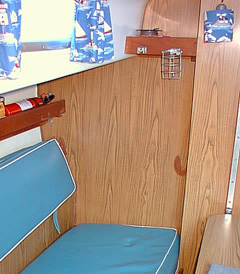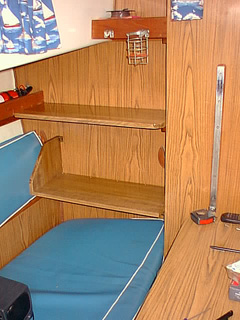Alberg 35 Saloon Shelving
by Tom Alley, Hull #212
As an amateur radio operator, I have been pining to make use of the insulated backstay found on most Alberg 35s. Last year I finally managed to find a suitable transceiver that would run off of a 12 volt DC supply (i.e., the house batteries). This spring, the challenge was to find a place in the boat to put the radio. I also wanted to find a more permanent home for the "boom box" that we use for listening to music, tapes and CDs. Some extra shelving seemed to offer the answer.

- One has a desk available for writing that does not block access to the companionway or the head. This is true whether underway or in port.
- On Tomfoolery, there is a hanging locker just forward of this bulkhead, which provides a simple wiring path for the power cables that will be required for the shortwave transmitter. (Full transmit power will draw approximately 20 Amps, requiring #4 battery cables.)
- We rarely use the settees for sleeping, but any shelving placed here should, if possible, leave some "kick space" the the berth's occupant.
After pricing teak I decided to try an experiment and make the shelves out of either oak or poplar. Since an experiment with poplar is about half as expensive as one using oak, the poplar species won out. After being cut and trimmed to fit, each shelf was stained to match the interior as closely as possible. Since there was no "formica" stain available, I had to settle for a dark oak stain.

The lower shelf was located so as to be at the same level as the main cabin table. This was done primarily for ergonomic reasons. Note that both shelves stick out beyond the corner of the bulkhead. The upper shelf is approximately 10 inches deep and the lower shelf is approximately 11 inches deep. Shelf depth was dictated by the equipment that will be mounted there.
The next most difficult task was to "level" the shelves when they were installed. Over the winter the boat has settled slightly and is not quite level, so it is not as simple as setting a spirit level against the bulkhead and drilling some holes. It turns out that neither of the existing shelves are "straight" either. I finally decided to use the base of the settee as a reference datum and simply measured up from this surface and set the shelves parallel to it. A spirit level did show that the two settee bases were out of level by the same amount and in the same direction, so I am assuming that when the boat is floated that these surfaces will be "level".

If you want to do something similar, pay attention to the number of batteries required by the boom boxes you look at. Remember that eight "D" cells equal 12 volts. More "D" cells mean a higher voltage and that you will not be able to use your ship's DC system to supply power. I was surprised by the number of boom boxes that require 15 VDC to run (10 "D" cells).
Bolted underneath the upper shelf is an Azden 2 meter amateur VHF transceiver. Immediately below is an Icom 725 amateur shortwave transceiver and general coverage receiver. To the left of the transceiver is a standing wave and power meter (top) and the antenna tuner (bottom) that will be used to load power into the insulated backstay. Outboard of the the meter and tuner is my straight key (for sending Morse code).
Not yet installed are some nylon straps that will be used to prevent the equipment from making unplanned migrations from the shelves and an extra 12 VDC outlet that will be mounted beneath the upper shelf.
For a more detailed look at the technical issues of installing a shortwave radio in an Alberg 35, look for a future article on this web site.
Please send any comments or questions to This email address is being protected from spambots. You need JavaScript enabled to view it.. All photos are from "Tomfoolery", Hull #212.


